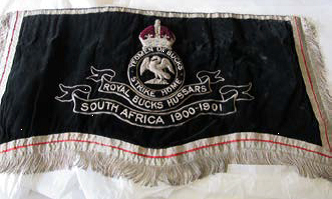The banner reflects the adoption of a new regimental cap badge, designed by Regimental Sergeant Major (later Lieutenant Quartermaster) Charles W. Cole in 1905, and worn from 1906 onwards. Cole reputedly based the design with the motto, ‘Yeomen of Bucks Strike Home’, on one of the old regimental guidons then laid up in the church at Stowe. The battle honour ‘South Africa, 1900-01’ was awarded for the contribution of the regiment to the Imperial Yeomanry in the South African War (1899-1902), the Royal Bucks Hussars forming the basis for the 37th and 38th Companies of the 10th Battalion, IY and the 56th and 57th Companies of the 15th Battalion, IY. There would have been a banner for each of the two kettle drums borne by the drum horse.
The visibility of the bands of the yeomanry, militia and rifle volunteers had a major influence in the projection of military values within British society in the course of the nineteenth century. Serving in these auxiliary forces was as much social as military pursuit and was characterised by parades, march outs, field days, and wider entertainments that all helped publicise military virtues. Indeed, it is usually suggested that such local military bands helped spread the popularity of music making in Victorian England generally. Important in terms of recruitment, military bands appeared regularly at local fetes and other similar events, sometimes advertising their services.
The Royal Bucks Hussars band was in constant employment under its long-serving bandmaster, Ambrose Nelson, who succeeded his father, George, in the position in 1831. Nelson, who owned a pianoforte and music selling business in Buckingham and later resided at Great Horwood, dispensed with the reed section to make the band a purely brass one. Some musicians were local, but most came from London and elsewhere. The decision to concentrate solely on local musicians was taken when Nelson finally retired at the age of 73 in 1890. Nelson’s successor was Robert Payne, formerly with the 4th Hussars. Presented with a suitable silver salver on his retirement, Nelson died in 1904.
Under Payne’s direction, the band was one of a few military bands to make early recordings on Berliner cylinders in November 1899. The band’s rendition of ‘The Deep Blue Sea’ with a piccolo solo on 28 November 1899 survives in the sound collection of the British Library.
The band played at such local events as the marriage of Thomas Fremantle at Swanbourne in October 1859; the Leckhamstead Club anniversary meeting in June 1860; the Chetwode and Barton Hartshorn harvest home in September 1864; the harvest festival at Great Horwood in September 1872; the Buckingham Oddfellows Fete in July 1875; the christening of Egerton Hubbard’s son at Addington Park in July 1883; the golden wedding of the Hon. J. G. Hubbard at Addington in June 1887; and the flowers, fruit and vegetable show at Whittlebury Lodge in August 1887. There is a photograph of the band including the kettle drummer on his dappled horse drawn up at Beaconsfield on 21 June 1897 whilst waiting to escort Queen Victoria from Slough to Windsor on her return from the Diamond Jubilee celebrations in London.
The band does not appear to have been revived after the First World War when, in any case, what was now the Royal Bucks Yeomanry was converted to an artillery unit. Such kettle drums are still used by the mounted bands of the Household Division.
